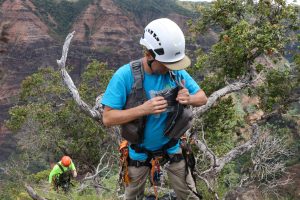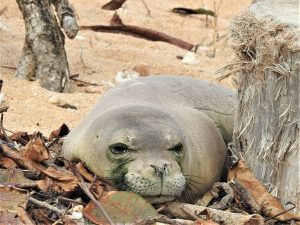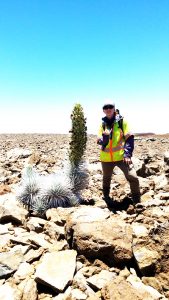Protecting Hawai‘i – from the mountains to the sea
Posted on Nov 30, 2021 in Capitol Connection, Featured, MainIf Hawai‘i is going to survive climate change, it will be up to us and future generations to lead the way. Much of the work falls to the state’s natural resource specialists who sometimes risk their own lives to protect “the rarest of the rare” native species. From hiking Maunakea’s frigid slopes and rappelling Waimea Canyon’s cliffs to monitoring miles of reefs and beaches, they work with community partners to preserve life as we know it in the islands and save even the smallest of our inhabitants from extinction.
A REAL CLIFFHANGER

Rappelling down cliffs in Waimea Canyon is just part of the job. (Photos, video production by: Dan Dennison.)
In case you missed it, you can still view a DLNR-produced documentary by Dan Dennison called “Cliff Dwellers of Kaua‘i and the people who hang with them!” at https://vimeo.com/596087910. The video, which aired on KHON in October, shows DLNR botanist Adam Williams and Scott Heintzman with the state’s Plant Extinction Prevention Program rappelling down steep canyon walls to save some of the endangered species that live there.
More than 250 native plants in Hawai‘i are close to extinction in their wild habitats, and the documentary shows what conservationists do to get cuttings or seeds into seed banks for propagation and species survival. “The program depicts truly world-class conservation management, reporting and partnerships,” said DLNR Division of Forestry and Wildlife administrator David Smith
PROTECTING MARINE WILDLIFE
How you can help protect wildlife – DLNR encourages the public to report anyone seen harassing wildlife in the islands, especially monk seals and turtles. Jason Redulla, DLNR’s conservation and resources enforcement chief, said photos and videos can serve as potential evidence, especially since DOCARE officers cover more than 700 miles of shoreline and nearly 1.6 million acres of state-owned land. To report illegal activity or wildlife harassment, call (808)643-DLNR or use the free DLNRTips app. Violations can also be reported to NOAA’s marine wildlife hotline at 888-256-9840.
STEWARDING MAUNAKEA
Whatever the future holds, Jessica Kirkpatrick, 32, will still be on the mountain, protecting Maunakea’s natural, cultural and historical resources. As someone born and raised on Hawai‘i island, she brings a homegrown passion to her work as the leader of a three-person natural resource team in the newly renamed UH Hilo Center for Maunakea Stewardship. The Center is responsible for protecting the 11,288-acre state-owned lands leased by the University of Hawai‘i. The stewardship involves everything from public safety to Kirkpatrick’s work in monitoring areas and educating people about the mountain’s resources.
Kirkpatrick ‘s team protects some 250 historical and cultural sites and guards against invasive species that might threaten the mountain’s delicate ecosystem, including endangered species such as the Maunakea silversword and the palila bird and other endemic species, such as the wēkiu bug (the size of a grain of rice). “Our Maunakea Invasive Species Management Plan is consistent with the governor’s Interagency Biosecurity Plan,” she said. “One of my jobs is to keep ants off the mountain.” The Center’s team has received awards for its commitment to environmental stewardship and protection of archaeological and cultural sites.
A two-degree graduate of UH-Hilo, Kirkpatrick survived a bout of hypothermia when she was caught in a rainstorm at the 12,500-foot level, but remains a fierce guardian of the mountain’s inhabitants. She wants to work more closely with the state Department of Land and Natural Resources on areas where they can help each other. “Our Center has a greenhouse, and we’d like to help with the propagation of native plants. We’re all trying to protect the species up there for future generations to enjoy.”

